24 have author last names that start with T have author last names that start with T

Ambrose Bierce and the Dance of Death uses psychoanalytic theory in combination with historical, cultural, and literary contexts to examine the complex motif of death in a full range of Bierce’s writings. Scholarly interest in Bierce, whose work has long been undervalued, has grown significantly in recent years. This new book contributes to the ongoing reassessment by providing new contexts for joining the texts in his canon in meaningful ways.
Previous attempts to consider Bierce from a psychological perspective have been superficial, often reductive Freudian readings of individual stories such as “An Occurrence at Owl Creek Bridge” and “The Death of Halpin Frayser.” This new volume not only updates these interpretations with insights from post-Freudian theorists but uses contemporary death theory as a framework to analyze the sources and expressions of Bierce’s attitudes about death and dying. This approach makes it possible to discern links among texts that resolve some of the still puzzling ambiguities that have—until now—precluded a fuller understanding of both the man and his writings.
Lively and engaging, Ambrose Bierce and the Dance of Death adds valuable new insights not only to the study of Bierce but to that of nineteenth-century American literature in general.
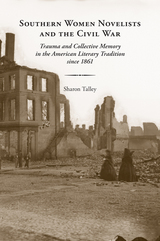
evolving collective memory by penning journals and diaries, historical accounts, memoirs,
and literary interpretations of the war. While a few of these writings—most notably Mary
Chesnut’s diaries and Margaret Mitchell’s novel, Gone with the Wind—have been studied in
depth by numerous scholars, until now there has been no comprehensive examination of
Civil War novels by southern women. In this welcome study, Sharon Talley explores works
by fifteen such writers, illuminating the role that southern women played in fashioning
cultural identity in the region.
Beginning with Augusta Jane Evans’s Macaria and Sallie Rochester Ford’s Raids and
Romance of Morgan and His Men, which were published as the war still raged, Talley offers
a chronological consideration of the novels with informative introductions for each time
period. She examines Reconstruction works by Marion Harland, Mary Ann Cruse, and
Rebecca Harding Davis, novels of the “Redeemed” South and the turn of the century by
Mary Noailles Murfree, Ellen Glasgow, and Mary Johnston, and narratives by Evelyn Scott,
Margaret Mitchell, and Caroline Gordon from the Modern period that spanned the two
World Wars. Analysis of Margaret Walker’s Jubilee (1966), the first critically acclaimed Civil
War novel by an African American woman of the South, as well as other post–World War
II works by Kaye Gibbons, Josephine Humphreys, and Alice Randall, offers a fitting conclusion
to Talley’s study by addressing the inaccuracies in the romantic myth of the Old South
that Gone with the Wind most famously engraved on the nation’s consciousness.
Informed by feminist, poststructural, and cultural studies theory, Talley’s close readings
of these various novels ultimately refute the notion of a monolithic interpretation of
the Civil War, presenting instead unique and diverse approaches to balancing “fact” and
“fiction” in the long period of artistic production concerning this singular traumatic event
in American history.
Sharon Talley, professor of English at Texas A&M University–Corpus Christi, is the author
of Ambrose Bierce and the Dance of Death and Student Companion to Herman Melville. Her
articles have appeared in American Imago, Journal of Men’s Studies, and Nineteenth-Century
Prose.
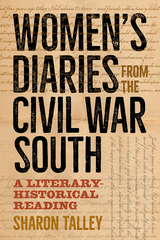
“Traditionally, narratives of war have been male,” Sharon Talley writes. In the pages that follow, she goes on to disrupt this tradition, offering close readings and comparative studies of fourteen women’s diaries from the Civil War era that illuminate women’s experiences in the Confederacy during the war.
While other works highlighting individual diaries exist—and Talley notes that there has been a virtual explosion of published primary sources by women in recent years—this is the first effort of comprehensive synthesis of women’s Civil War diaries to attempt to characterize them as a distinct genre. Deeply informed by autobiographical theory, as well as literary and social history, Talley’s presentation of multiple diaries from women of differing backgrounds illuminates complexities and disparities across female wartime experiences rather than perpetuating overgeneralizations gleaned from a single diary or
preconceived ideas about what these diaries contain.
To facilitate this comparative approach, Talley divides her study into six sections that are organized by location, vocation, and purpose: diaries of elite planter women; diaries of women on the Texas frontier; diaries of women on the Confederate border; diaries of espionage by women in the South; diaries of women nurses near the battlefront; and diaries of women missionaries in the Port Royal Experiment. When read together, these writings illustrate that the female experience in the Civil War South was not one but many.
Women’s Diaries from the Civil War South: A Literary-Historical Reading is an essential text for scholars in women’s studies, autobiography studies, and Civil War studies alike, presenting an in-depth and multifaceted look at how the Civil War reshaped women’s lives in the South—and how their diverse responses shaped the course of the war in return.
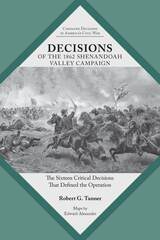
Decisions of the 1862 Shenandoah Valley Campaign explores the critical decisions made by Confederate and Union commanders during the battle and how these decisions shaped its outcome. Rather than offering a history of the battle, Robert G. Tanner hones in on a sequence of critical decisions made by commanders on both sides of the contest to provide a blueprint of Jackson’s Valley Campaign at its tactical core. Identifying and exploring the critical decisions in this way allows students of the battle to progress from a knowledge of what happened to a mature grasp of why events happened.
Complete with maps and a driving tour, Decisions of the 1862 Shenandoah Valley Campaign is an indispensable primer, and readers looking for a concise introduction to the battle can tour this sacred ground—or read about it at their leisure—with key insights into the campaign and a deeper understanding of the Civil War itself.
Decisions of the 1862 Shenandoah Valley Campaign is the seventeenth in a series of books that will explore the critical decisions of major campaigns and battles of the Civil War.
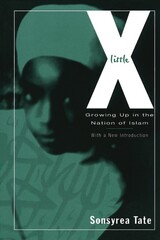
"A temperate and sympathetic treatment of an African-American family's religious evolution." —Publishers Weekly
"A compelling story. It provides an honest, inside view of one of America's most controversial religious movements and perceptively points to social tensions of race, gender and religious identity." —Kirkus Reviews
"Extremely valuable. Recent literature is interested almost exclusively in male leaders. Tate's book provides a new perspective. I have used the book in a number of teaching contexts to very good results." —Judith Weisenfeld, Vassar College
In Little X, Sonsyrea Tate reveals, through the acute vision and engaging voice of a curious child, the practices and policies of the mysterious organization most know only through media portrayals of its controversial leaders Elijah Muhammad, Malcolm X, and Louis Farrakhan. First published in 1997, Little X chronicles the multigenerational experience of Tate's family, who broke from the traditional black church in the 1950s to join the radical Nation of Islam, then struggled to remain intact through disillusionment, shifting loyalties, and forays into Orthodox Islam.
Little X is also an absorbing story of a little girl whose strict Muslim education filled her with pride, confidence, and a longing for freedom, of a teenager in an ankle-length dress and headwrap struggling to fit in with non-Muslim peers, and of a young woman whose growing disillusionment with the Nation finally led to her break with the Muslim religion. Little X offers a rare glimpse into the everyday experience of the Nation of Islam, and into a little-understood part of America's history and heritage.
Sonsyrea Tate-Montgomery has been a staff writer for the Virginian Pilot, Chicago Tribune, and the Washington Post. The recipient of four coveted Echoes of Excellence awards from the National Association of Black Journalists, Tate has also worked as assistant to Congresswoman Eleanor Holmes Norton. She currently works as a political reporter for The Gazette, a Post-Newsweek publication.
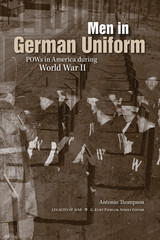
Examining the largest prisoner-of-war handling operation in U.S. history, this book offers a meticulous account of the myriad history, this book offers a meticulous account of the myriad problems—as well as the impressive successes—that came with problems—as well as the impressive successes—that came with housing 371,000 German POWs on American soil during World War II. Antonio Thompson draws on extensive archival research to probe the various ways in which the U.S. government strove to comply with the Geneva Convention’s mandate that enemy prisoners be moved from the war zone and given food, shelter, and clothing equal to that provided for American soldiers.
While the prisoners became a ready source of manpower for the labor- starved American home front and received small wages in return, their stay in the United States generated more than a few difficulties, which included not only daunting logistics but also violence within the camps. Such violence was often blamed on Nazi influence and control; however, as Thompson points out, only a few of the prisoners were actually Nazis. Because the Germans had cobbled together military forces that included convicts, their own POWs, volunteers from neutral nations, and conscripts from occupied countries, the bonds that held these soldiers together amid the pressures of combat dissolved once they were placed behind barbed wire. When these “men in German uniform,” who were not always Germans, donned POW garb, their former social, racial, religious, and ethnic tensions quickly reemerged.
To counter such troubles, American authorities organized various activities—including sports, arts, education, and religion—within the
POW camps; some prisoners even participated in an illegal denazification program created by the U.S. government. Despite the problems, Thompson argues, the POW-housing program proved largely successful, as Americans maintained their reputation for fairness and humane treatment during a time of widespread turmoil.

Responding to his brother’s plea for the sons of Maine to join the Union cause, Charles found himself a noncommissioned officer fighting in the disastrous Battle of First Bull Run. All told, Howard fought in several major battles of the Eastern Theater, including Antietam, Fredericksburg, Chancellorsville, and Gettysburg, and went on to participate in various military actions in the Western Theater including Sherman’s bloody Atlanta Campaign. He was wounded twice, first at the Battle of Fair Oaks and again at Fredericksburg. Yet, despite facing the worst horrors of war, Howard rarely wavered in his faith and rose steadily in rank throughout the conflict. By war’s end, he was a brevet brigadier general in command of the 128th U.S. Colored Troop Regiment.
Howard’s letters cover a wide-ranging period, from 1852 to 1908. His concern for his family is typical of a Civil War soldier, but his exceptionally firm reliance on divine providence is what makes these letters an extraordinary window into the mind of a Civil War officer. Howard’s grounded faith was often tested by the viciousness of war, and as a result his letters are rife with stirring confessions and his emotional grappling with the harsh realities he faced. Howard’s letters expose the greater theological and metaphysical dilemmas of the war faced by so many on both sides.
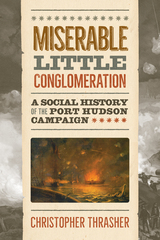
Previous accounts of these events have rested on the leaders, well-known figures, and familiar faces of the Civil War. Here, social historian Christopher Thrasher draws from a robust collection of archival sources to tell the story of the common people’s experience throughout the Port Hudson Campaign: the soldiers who fought, the civilians who persisted, and the men who persevered, for those long days.
With more than forty illustrations and maps depicting the battles of Port Hudson and the defenses of the place itself, Miserable Little Conglomeration builds upon previous scholarship to present a social history of this campaign through the eyes of the people who lived, fought, and died within it.
Filling a long-empty gap within Civil War scholarship, Thrasher’s fresh approach to the Port Hudson campaign will be of interest to Civil War scholars, students of Louisiana history, and younger learners who are interested in the voices of American history.
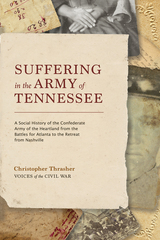
Winner of the 2022 Douglas Southall Freeman Award!
Confederate historiography of the Civil War is rich with stories of leaders and decision makers—oft-repeated names immortalized by their association with America’s great trial of the 1860s. But while scholarship exploring the roles of Confederate generals and politicians abounds, a major part of the story remains untold: that of the ordinary people who became soldiers and turned the very pages of Civil War history.
Part of the Voices of the Civil War series, Suffering in the Army of Tennessee doesn’t just draw upon one single diary or letter collection, and it does not use brief quotations as a way to fill out a larger narrative. Rather, across eight chapters spanning the Atlanta Campaign to the Battle of Nashville in 1864, Thrasher draws upon a remarkably broad set of primary sources—newspapers, manuscripts, archives, diaries, and official documents—to tell a story that knits together accounts of senior officers, the final campaigns of the Western Theater, and the experiences of the civilians and rebel soldiers who found themselves deep in the trenches of a national reckoning. While volumes have been written on the Atlanta Campaign or the Battles of Nashville and Franklin, no previous historian has constructed what amounts to a sweeping social history of the Army of Tennessee—the daily details of soldiering and the toll it took on the men and boys who mustered into service foreseeing only a small skirmish among the states.
While this volume will appeal to Civil War buffs and military history scholars, its accessible structure and engaging narrative style will likewise captivate American history enthusiasts, students, and general readers.

Renowned poet Richard Tillinghast’s wanderlust and restless spirit are nearly as well known as his verses. This book of essays captures that penchant to wander, yet Journeys into the Mind of the World is not merely a compilation of travel stories—it is a book of places. It explores these chosen locations—Ireland, England, India, the Middle East, Tennessee, Hawaii—in a deeper way than would be typical of travel literature, attempting to enter not just the world, but “the mind of the world”—the roots and history of places, their political and cultural history, spiritual, artistic, architectural, and ethnic dimensions.
Behind each essay is the presence, curiosity, and intelligence of the author himself, who uses his experience of the places he visits as a way of bringing the reader into the equation. Tillinghast illuminates his travels with a brilliant eye, a friendly soul, and eclectic knowledge of a variety of disparate areas—Civil War history, Venetian architecture, Asian cultures, Irish music, and the ways of out-of-the-way people. This attention to history and cultural embeddedness lends unique perspectives to each essay.
At the heart of his journeys are his deep roots in the South, tracing back to his hometown in Tennessee. The book explores not only Tillinghast’s childhood home in Memphis, but even the time before his birth when his mother lived in Paris. Readers will feel a sense of being everywhere at once, in a strange simultaneity, a time and place beyond any map or guidebook.

Renowned poet Richard Tillinghast’s wanderlust and restless spirit are nearly as well known as his verses. This book of essays captures that penchant to wander, yet Journeys into the Mind of the World is not merely a compilation of travel stories—it is a book of places. It explores these chosen locations—Ireland, England, India, the Middle East, Tennessee, Hawaii—in a deeper way than would be typical of travel literature, attempting to enter not just the world, but “the mind of the world”—the roots and history of places, their political and cultural history, spiritual, artistic, architectural, and ethnic dimensions.
Behind each essay is the presence, curiosity, and intelligence of the author himself, who uses his experience of the places he visits as a way of bringing the reader into the equation. Tillinghast illuminates his travels with a brilliant eye, a friendly soul, and eclectic knowledge of a variety of disparate areas—Civil War history, Venetian architecture, Asian cultures, Irish music, and the ways of out-of-the-way people. This attention to history and cultural embeddedness lends unique perspectives to each essay.
At the heart of his journeys are his deep roots in the South, tracing back to his hometown in Tennessee. The book explores not only Tillinghast’s childhood home in Memphis, but even the time before his birth when his mother lived in Paris. Readers will feel a sense of being everywhere at once, in a strange simultaneity, a time and place beyond any map or
guidebook.
RICHARD TILLINGHAST is the author of three recent books of poetry: Sewanee Poems (Evergreen, 2009; second edition, 2012), Selected Poems (Dedalus, Dublin, 2009), and Wayfaring Stranger (Word Palace, 2012). Among his nonfiction books are Finding Ireland (University of Notre Dame, 2008) and An Armchair Traveller’s History of Istanbul (Haus Publishing, London, 2012).

In this second edition of Powerhouse for God, Titon revisits The Fellowship Independent Baptist Church nearly four decades later. Brother John Sherfey, the charismatic preacher steeped in Appalachian tradition has passed away and left his congregation to his son, Donnie, to lead. While Appalachian Virginia has changed markedly over the decades, the town of Stanley and the Fellowship Church have not. Titon relates this rarity in his new Afterword: a church founded on Biblical literalism and untouched by modern progressivism in an area of Appalachia that has seen an evolution in population, industry, and immigration.
Titon’s unforgettable study of folklife, musicology, and Appalachian religion is available for a new generation of scholars to build upon.
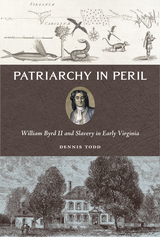
Byrd himself was perhaps the early colonial epitome of a patriarch, and typically, when historians examine Byrd and the prominence of patriarchal thought in colonial Virginia, they examine his relationships with his immediate family. In this book, however, Dennis Todd examines the patriarchal relations between Byrd and the workers on his plantations—his apprentices, his wageworkers, his overseers, his white servants, and especially his slaves. In doing so, this book illuminates a neglected stage in the formation of slavery in Virginia. Todd argues that patriarchal principles, which are often assumed to have justified slavery and to have offered a template for slave management, in fact did neither. Byrd was not the only Virginian to wrestle with the contradictions between patriarchal values and the realities of slavery, but few were as articulate.
In examining Byrd through the twin lens of slavery and patriarchy, Patriarchy in Peril makes an important contribution to our understanding of the man and his place in Virginia society as well as the contentious formation of early America.
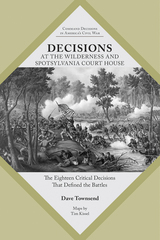
The successive battles of The Wilderness and Spotsylvania Court House opened Lt. Gen. Ulysses S. Grant’s 1864 Overland Campaign. As the first confrontation between Union and Confederate leaders Grant and Gen. Robert E. Lee, these two bloody battles signaled the new reality of war. The fighting at the Battle of The Wilderness, immediately followed by the Battle of Spotsylvania Court House, was costly for both sides, and while the Union army could replace its losses, Lee’s Army of Northern Virginia could not. It would be exactly one year from Grant’s orders to Gen. George G. Meade stating that Lee’s army would be his objective until the surrender at Appomattox.
Decisions at The Wilderness and Spotsylvania Court House introduces readers to critical decisions made by Confederate and Union commanders throughout the two costly meetings. Dave Townsend examines the decisions that prefigured the action and shaped the course of each battle as it unfolded. Rather than a linear history of the battles, Townsend’s discussion of the critical decisions presents readers with a vivid blueprint of the battles’ developments. Exploring the critical decisions in this way allows the reader to progress from a sense of what happened in these battles to why they happened as they did.
Complete with maps and a guided tour, Decisions at The Wilderness and Spotsylvania Court House is an indispensable primer, and readers looking for concise introductions to the battles can tour this sacred ground—or read about it at their leisure—with key insights into the battles and a deeper understanding of the Civil War itself.
Decisions at The Wilderness and Spotsylvania Court House is the seventh in a series of books that will explore the critical decisions of major campaigns and battles of the Civil War.

rate, rising from fifty thousand at the outbreak of revolution to more than a million as the nation
edged toward civil war. As the Second Great Awakening swept through the Old Southwest, it generated
religious enthusiasm among Methodist and Baptist converts who were intent upon replacing
old forms of Protestantism with an evangelical vibrancy that reflected and often contributed
to the unsettled social relations of the new republic. No place was better suited to embrace this
enthusiasm than Kentucky. In Born of Water and Spirit, Richard C. Traylor explores the successes
and failures of Baptists in this area, using it as a window into the elements of Baptist life
that transcended locale.
Traylor argues that the achievements of Baptists in Kentucky reflect, in many ways, their success
and coming of age in the early national period of America. The factionalism that characterized
frontier Baptists, he asserts, is an essential key to understanding who the colonial Baptists had
been, who they were becoming in the late eighteenth through the mid-nineteenth centuries, and
who they would become after the Civil War.
In this highly nuanced study, Traylor looks at the denomination in light of what he calls its
“Baptist impulse”—the movement’s fluid structure and democratic spirit. These characteristics
have proven to be its greatest strength as well as the source of its most terrible struggles. Yet, confronting
theological clashes, along with the challenges that come with growth, forged the Baptist
identity and shaped its future.
The first three chapters examine the primary elements of the impulse: rituals of conversion,
baptism, and communion; the Baptist preacher; and the significance of the local church to the
sect. Following these chapters are explorations of the reformations and forces of change in the
early to mid-1800s, the role of women and African Americans in developing the group, and the
refinement and reorientation of priorities from 1840 to 1860. This important denominational history
will be of great value to scholars of American religious history and the history of the early
American republic.
Richard C. Traylor is a professor of history at Hardin-Simmons University in
Abilene, Texas. His articles have been published in Baptist History and Heritage and
Missouri Historical Review.
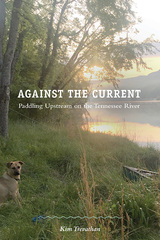
In August 1998 Kim Trevathan summoned his beloved 45-pound German shepherd mix, Jasper, and paddled a canoe down the Tennessee River, an adventure chronicled in Paddling the Tennessee River: A Voyage on Easy Water. Twenty years later, in Against the Current: Paddling Upstream on the Tennessee River, he invites readers on a voyage of light-hearted rumination about time, memory, and change as he paddles the same river in the same boat—but this time going upstream, starting out in early spring instead of late summer. In sparkling prose, Trevathan describes the life of the river before and after the dams, the sometimes daunting condition of its environment, its banks’ host of evolving communities—and also the joys and follies of having a new puppy, 65-pound Maggie, for a shipmate.
Trevathan discusses the Tennessee River’s varied contributions to the cultures that hug its waterway (Kentuckians refer to it as a lake, but Tennesseans call it a river), and the writer’s intimate style proves a perfect lens for the passageway from Kentucky to Tennessee to Alabama and back to Tennessee. In choice observations and chance encounters along the route, Trevathan uncovers meaningful differences among the Tennessee Valley’s people—and not a few differences in himself, now an older, wiser adventurer.
Whether he is struggling to calm his land-loving companion, confronting his body’s newfound aches and pains, craving a hard-to-find cheeseburger, or scouting for a safe place to camp for the night, Trevathan perseveres in his quest to reacquaint himself with the river and to discover new things about it. And, owing to his masterful sense of detail, cadence, and narrative craft, Trevathan keeps the reader at the heart of the journey. The Tennessee River is a remarkable landmark, and this text exhibits its past and present qualities with a perspective only Trevathan can provide.

Trevathan began by exploring the rivers and creeks of his childhood: the Blood River and Clarks River in western Kentucky. He soon ventured out to the Wolf River, the Big South Fork of the Cumberland, and other waterways in Tennessee. In 2008, he looped around the country with trips to Indiana’s Tippecanoe River, Montana’s Clearwater River, Oregon’s Deschutes and Rogue Rivers, and Colorado’s Dolores River, as well as adventures on such southeastern rivers as the Edisto, the Tellico, and the Nantahala. To Trevathan, paddling upstream became a sort of religion, with a vaporous deity that kept him searching. Each excursion yielded something unexpected, from a near-drowning in the Rogue River to a mysterious fog bank that arose across the Nantahala at midday.
Throughout Liminal Zones, Trevathan considers what makes certain places special, why some are set aside and protected, why others are not, and how free-flowing streams remain valuable to our culture, our history, and our physical and spiritual health. This contemplative chronicle of his journeys by water reveals discoveries as varied and complex as the rivers themselves.
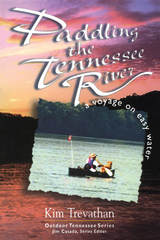
Over the course of the five-week voyage, Trevathan rediscovered the people and places that made history on the Tennessee’s banks. He crossed the path of the explorer Meriwether Lewis along the Natchez Trace, noted the sites of Ulysses S. Grant’s Civil War battles, and passed Hiwassee Island, the spot where a teenaged runaway named Sam Houston lived with Cherokee Chief Jolly.
Trevathan also came to know the modern river’s dwellers, including a towboat pilot, two couples who traded in their landlocked homes for life on the river, a campground owner, and a meteorologist for NASA. He placed his life in the hands of U.S. Army Corps of Engineers lock operators as he and Jasper navigated the river’s nine dams.
Paddling the Tennessee River is a powerful travel narrative that captures the river’s wild, turbulent, and defiant past and confronts what it has become—an overused and overdeveloped series of lakes. But first and foremost, the book is the story of a man and his dog, riding low enough to smell the water and to discover the promise of a slow river running through the southern heartland.
The Author: Kim Trevathan, who earned his M.F.A. in creative writing at the University of Alabama, works as a new media writer and producer and writes a column for the Maryville Daily Times. His essays and short stories have been published in The Distillery, New Millennium Writings, The Texas Review, New Delta Review, and Under the Sun. He lives in Rockford, Tennessee.
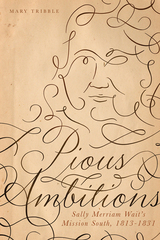
In 1812 at the age of nineteen, Sally Merriam Wait experienced her conversion. For those raised in an evangelical church during the religious fervor of the Second Great Awakening, conversion represented a key moment in a young person’s life, marking the transition from childhood and frivolity to the duties of a pious life. Sally’s conversion also marked the beginning of her journal.
Wait grew up in a New England swept with revival. Her letters reveal a northernborn woman with anti-slavery leanings engaging with an unfamiliar environment in the slave-holding South; she comes to embrace the principles of a market economy in Jacksonian America, while attending to her developing religious faith. Her decisions are shaped by a surging evangelical movement, changes in the American economy, the rise of women’s social agency, a fracturing of political traditions, and the moral conflicts inherent in a slave economy. At its simplest, Sally’s life is the tale of a nineteenth-century woman endeavoring to make her mark on the world while striving to develop her faith.
Pious Ambitions establishes Sally Merriam Wait as a significant figure in North Carolina and Baptist history. Her ambition led her from young convert to devoted wife of Reverend Samuel Wait, the first president and founder of Wake Forest University. Her journal was passed down carefully from generation to generation until it found its way in 1993 to the Special Collections and Archives at Z. Smith Reynolds Library at Wake Forest University in Winston-Salem, North Carolina, along with a large cache of letters and other documents. In examining this trove and reconstructing the life of Wait, Mary Tribble provides a rare glimpse into the spiritual education of a young woman who nevertheless successfully navigated the rise of capitalism in the market economy of the early nineteenth century.
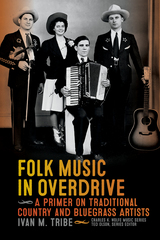
Originally built around interviews with these figures and their close associates, these thirty-nine revised articles yield new information from a variety of sources, much from Bear Family boxed sets as well as counsel, advice, and knowledge shared by other music scholars. Tribe's profiles cover musicians and bands that were bluegrass pickers and singers themselves, as well as some musicians who are often characterized as traditional country musicians. Some led bands for all or part of their careers, while others ranked as noted sidemen or band members. Others composed songs that have become popular, indeed often standard, fare in the bluegrass field.
As part of the Charles K. Wolfe Music Series, formed in honor of the late music scholar, Folk Music in Overdrive succinctly advances traditional music scholarship and Wolfe’s own love of early country and bluegrass.
IVAN TRIBE is emeritus professor of history at the University of Rio Grande in Ohio. He is the author of The Stonemans: An Appalachian Family and the Music That Shaped Their Lives, Mountaineer Jamboree: Country Music in West Virginia, and Country: A Regional Exploration.
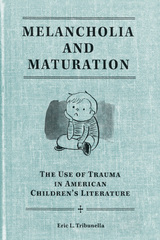
“Coming of age” in children’s fiction often means achieving maturity through the experience of trauma. In classics ranging from Old Yeller to The Outsiders, a narrative of psychological pain defies expectations of childhood as a time of innocence and play. In this provocative new book, Eric L. Tribunella explores why trauma, especially the loss of a loved object, occurs in some of the most popular and critically acclaimed twentieth-century American fiction for children.
Tribunella draws on queer theory and feminist revisions of Freud’s notion of melancholia, which is described as a fundamental response to loss, arguing that the low-grade symptoms of melancholia are in fact what characterize the mature, sober, and responsible American adult. Melancholia and Maturation looks at how this effect is achieved in a society that purports to protect youngsters from every possible source of danger, thus requiring melancholia to be induced artificially.
Each of the book’s five chapters focuses on a different kind of lost object sacrificed so as to propel the child toward a distinctively gendered, sexual, ethical, and national adulthood—from same-sex friends to the companionship of boy-and-his-dog stories, from the lost ideals of historical fiction about the American Revolution to the children killed or traumatized in Holocaust novels. The author examines a wide spectrum of works—including Jack London’s dog tales, the contemporary “realistic” novels of S. E. Hinton, and Newbery Medal winners like Johnny Tremain and Bridge to Terabithia.
Tribunella raises fundamental questions about the value of children’s literature as a whole and provides context for understanding why certain books become required reading for youth.
Eric L. Tribunella is assistant professor of English at the University of Southern Mississippi. His articles have been published in Children’s Literature Association Quarterly, Children’s Literature in Education, The Lion and the Unicorn: A Critical Journal of Children’s Literature, and Children’s Literature.
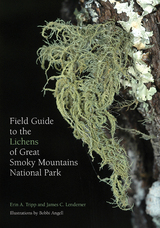
With 909 recognized species of lichens, Great Smoky Mountains National Park (GSMNP) is home to more of these lichenized fungi than any other national park in the United States, as well as nearly half of all species known to occur in eastern North America. There is a great deal of room for scientific exploration, inquiry, and systematic description in the realm of lichenology. In Field Guide to the Lichens of Great Smoky Mountains National Park, Erin Tripp and James Lendemer take on the formidable task of creating an all-in-one resource for Park exploration, including lichen distribution maps, tools for identification, vivid photographs and illustrations, and even field notes from their own research campaigns. In the process, the authors create a touchstone for lichen taxonomy and ecology, and they inspire others—researchers as well as casual observers—to take interest in the incredible biodiversity of the Great Smoky Mountains. Biologists, botanists, visitors to the park, naturalists, and others interested in the flora and fauna of both the southern Appalachians and GSMNP will thoroughly enjoy this lovingly prepared field guide.
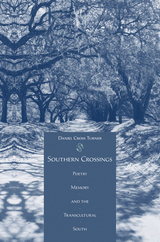
“Daniel Cross Turner has made a key contribution to the critical study and appreciation of the diverse field of contemporary Southern poetics. “Southern Crossings” crosses a gulf in contemporary poetry criticism while using the idea—or ideas, many and contrary—of “Southernness” to appraise poetries created from the profuse, tangled histories of the region. Turner’s close readings are dynamic, even lyrical. He offers a new understanding of rhythm’s central place in contemporary poetry while considering the work of fifteen poets. Through his focus on varied yet interwoven forms of cultural memory, Turner also shows that memory is not, in fact, passé. The way we remember has as much to say about our present as our past: memory is living, shifting, culturally formed and framed. This is a valuable and important book that entwines new visions of poetic forms with forms of regional remembrance and identity.”—Natasha Trethewey, Pulitzer Prize winner and author of Native Guard: Poems
Offering new perspectives on a diversity of recent and still-practicing southern poets, from Robert Penn Warren and James Dickey to Betty Adcock, Charles Wright, Yusef Komunyakaa, Natasha Trethewey, and others, this study brilliantly illustrates poetry’s value as a genre well suited to investigating historical conditions and the ways in which they are culturally assimilated and remembered.
Daniel Cross Turner sets the stage for his wide-ranging explorations with an introductory discussion of the famous Fugitive poets John Crowe Ransom, Allen Tate, and Donald Davidson and their vision of a “constant southerness” that included an emphasis on community and kinship, remembrance of the Civil War and its glorified pathos of defeat, and a distinctively southern (white) voice. Combining poetic theory with memory studies, he then shows how later poets, with their own unique forms of cultural remembrance, have reimagined and critiqued the idealized view of the South offered by the Fugitives. This more recent work reflects not just trauma and nostalgia but makes equally trenchant uses of the past, including historiophoty (the recording of history through visual images) and countermemory (resistant strains of cultural memory that disrupt official historical accounts). As Turner demonstrates, the range of poetries produced within and about the American South from the 1950s to the present helps us to recalibrate theories of collective remembrance on regional, national, and even transnational levels.
With its array of new insights on poets of considerable reputation—six of the writers discussed here have won at least one Pulitzer Prize for poetry—Southern Crossings makes a signal contribution to the study of not only modern poetics and literary theory but also of the U.S. South and its place in the larger world.
Daniel Cross Turner is an assistant professor of English at Coastal Carolina University. His articles, which focus on regional definition in national and global contexts and on aesthetic forms’ potential to record historical transitions, appear in edited collections as well as journals including Genre, Mosaic, the Southern Literary Journal, the Southern Quarterly, and the Mississippi Quarterly.
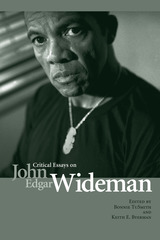
READERS
Browse our collection.
PUBLISHERS
See BiblioVault's publisher services.
STUDENT SERVICES
Files for college accessibility offices.
UChicago Accessibility Resources
home | accessibility | search | about | contact us
BiblioVault ® 2001 - 2024
The University of Chicago Press









